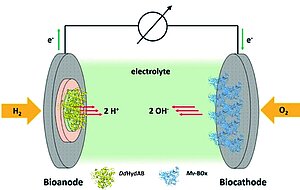A team of scientists of the Max Planck Institute for Chemical Energy Conversion and Ruhr-Universität Bochum designed a hydrogen/oxygen biofuel cell based on a hydrogenase enzyme. The results have been published in the journal Angewandte Chemie in May 2020.
Powerful enzymes require special conditions
Many enzymes that occur in nature are powerful catalysts, such as the so-called [FeFe]-hydrogenases. Hydrogenases are used by bacteria to produce hydrogen, while nitrogenases succeed in activating the strongest bond in nature in nitrogen (N2). Both enzymes are highly sensitive to oxygen, but use readily available non-precious metals in their active centres. Thus they could one day replace expensive precious metal catalysts. However, using such highly sensitive catalysts for biofuel cells is still one of the biggest challenges in sustainable energy conversion.
Biofuel cell realized with enzyme
The team around Professor Wolfgang Lubitz from MPI CEC and Prof. Wolfgang Schuhmann from RUB showed under which circumstances this is nevertheless possible. They used a so-called [FeFe] hydrogenase from the bacterium Desulfovibrio desulfuricans. Although this is a very efficient catalyst, it must be protected in the fuel cell from the oxygen required for operation at the second electrode.
In this work, the scientists integrated the [FeFe]-hydrogenase for the first time into a biofuel cell operated with so-called gas diffusion electrodes. In this cell, hydrogen and oxygen are transported to the enzymes through a membrane. The team embedded the enzyme in a matrix consisting of a so-called redox polymer, which fixes the enzyme to the gas-permeable electrode surface, protects the enzyme from the harmful effects of oxygen and also establishes electrical contact between the enzyme and the electrode. With this design, the fuel cell achieved previously unattained high current densities of 14 milliamperes per square centimetre and high power densities of 5.4 milliwatts per square centimetre.
Please find further information on the research topic at the RUB Website.
Original Publication: Szczesny, J., Birrell, J., Conzuelo, F., Lubitz, W., Ruff, A., Schuhmann, W.: Eine Redoxpolymer-basierte Gasdiffusions-H2-Oxidationsbioanode mit hoher Stromdichte unter Verwendung von [FeFe]-Hydrogenase aus Desulfovibrio desulfuricans in einer membranfreien Biobrennstoffzelle, in: Angewandte Chemie, 2020, DOI: 10.1002/ange.202006824, International Edition: DOI: 10.1002/anie.202006824

